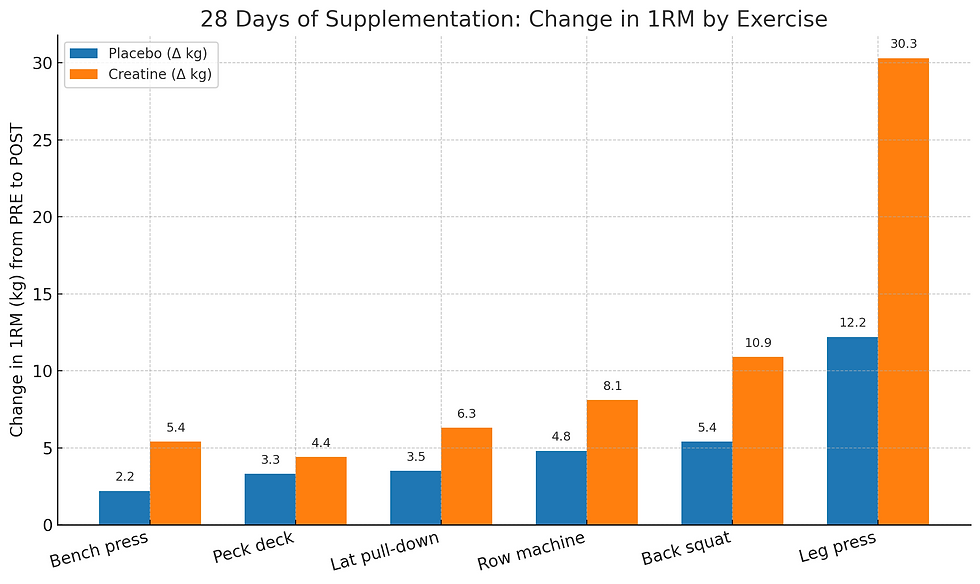Creatine: How Much Does It Actually Help And Should Hybrid Athletes take it?
- eliashuh
- 7 days ago
- 2 min read
Results That Might Surprise You
Creatine has been a hot topic on social media lately — and for good reason. It’s one of the most thoroughly researched supplements in sports performance. You’ll see influencers praising it and showing big results, but there’s always that question: is creatine the only thing they’re taking?
Some dismiss it as nothing more than “water weight” or bloating. My experience — and the research — says otherwise. Creatine’s performance advantage is clear, measurable, and in many cases, surprisingly large. Here are the reasons I definitely recommend it to all hybrid athletes.
What is Creatine?
Scientifically:
Creatine is a naturally occurring compound found mainly in muscle tissue, where it plays a critical role in the regeneration of adenosine triphosphate (ATP) — your muscles’ main energy source for short, high-intensity efforts. Supplementing with creatine increases your muscles’ phosphocreatine stores, allowing you to produce more ATP during repeated bouts of intense exercise.
Simply put:
Creatine helps your muscles “recharge” faster, letting you push harder for longer — whether that’s adding extra reps in the gym, sprinting faster, or recovering more quickly between efforts. So more energy to perform more work sets = more gains.
How Much Can It Really Help?
Two decades of research confirm creatine’s effectiveness. For example, a large meta-analysis by Lanhers et al. (2015) combined the results of 60 studies and found consistent improvements across multiple strength measures — showing that this isn’t just a one-off result from a single trial, but a well-established pattern.
But to answer the real question — how much can you expect to gain? — we can look at specific data.
One study (Almeida et al. 2022) measured changes in 1RM strength across several lifts over 28 days of creatine or placebo supplementation. Here’s what the results looked like:
Across all exercises tested — from bench press to leg press — creatine consistently outperformed placebo, with some of the biggest gains in lower-body movements. For example, the creatine group improved their leg press by 30.3 kgcompared to 12.2 kg in the placebo group over just four weeks.

Practical Use for Hybrid Athletes
If you want to integrate creatine effectively:
Form: Creatine monohydrate — the most studied and proven type.
Dose: 5–7 g daily (I personally take 6–7 g due to body weight). No cycling needed.
Timing: Any time of day — consistency matters more than timing.
Duration: Benefits build over weeks, not days. Think long-term use.
For hybrid athletes — those balancing strength and endurance — creatine is one of the few supplements with a proven track record for improving both power output and recovery without compromising aerobic performance.
Reference:
Lanhers, C., Pereira, B., Naughton, G. et al. Creatine Supplementation and Lower Limb Strength Performance: A Systematic Review and Meta-Analyses. Sports Med 45, 1285–1294 (2015). https://doi.org/10.1007/s40279-015-0337-4
Almeida, D., Pereira, R., Borges, E.Q. et al. Creatine Supplementation Improves Physical Performance, Without Negative Effects on Health Markers, in Young Weightlifters. J. of SCI. IN SPORT AND EXERCISE 4, 255–265 (2022). https://doi.org/10.1007/s42978-021-00147-9



Comments